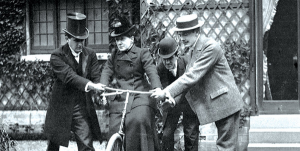In 1893, 53-year-old women’s sports pioneer, American Frances Willard became the first woman in the world to ride a bicycle. From the photos that have been handed down, readers of later generations can see that she is dressed in Victorian clothing, practicing her driving skills with the support of three gentlemen in suits and leather shoes.
Frances Willard did this because she felt that riding a bicycle could help women pursue freedom, help women go to the wider world, and even seek a change in social status. People at that time generally believed that bicycles were a combination of science and sports, a masterpiece of human creation, and a symbol of modernity.
A few years after Frances learned to ride, Song Yaoru’s 10-year-old daughter Song Ailing became the first Chinese girl to own a bicycle. According to American writer Xiang Meili, Song Ailing often traveled by bicycle with her father, and the bicycle became a symbol of civilization, advancement and wealth in the eyes of the Chinese people at that time.
As bicycles gradually spread from the upper class to the middle and lower classes, and as more and more cars ran rampant on the road, bicycles were once reduced to “the rides of the poor”, and the lanes were often occupied, and the scenery no longer existed. However, in recent years, first from the Nordic countries such as the Netherlands, and then to Germany, Italy, the United States and other places, after decades of highly concentrated motorized transportation, people have begun to pick up bicycles again, turning them from the forgotten Transportation has become the best choice for hipsters to travel. In China, more and more shared bicycles have also made many urban residents feel the convenience, environmental protection and health of bicycles. After a century, the bicycle is once again a symbol of progress
Post time: Feb-28-2023


